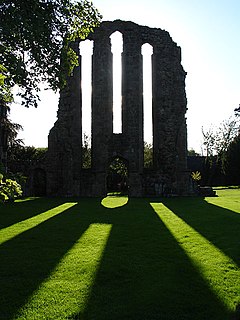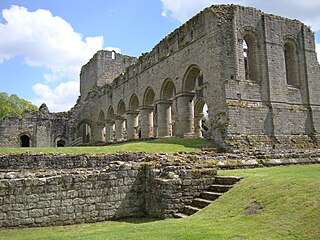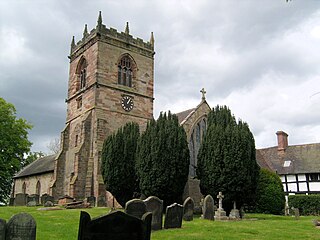Related Research Articles

Croxden Abbey, also known as "Abbey of the Vale of St. Mary at Croxden", was a Cistercian abbey at Croxden, Staffordshire, United Kingdom. A daughter house of the abbey in Aunay-sur-Odon, Normandy, the abbey was founded by Bertram III de Verdun of Alton Castle, Staffordshire, in the 12th century. The abbey was dissolved in 1538.

The Abbey Church of Saint Peter and Saint Paul, Shrewsbury is an ancient foundation in Shrewsbury, the county town of Shropshire, England.

Buildwas Abbey was a Cistercian monastery located on the banks of the River Severn, at Buildwas, Shropshire, England - today about two miles (3 km) west of Ironbridge. Founded by the local bishop in 1135, it was sparsely endowed at the outset but enjoyed several periods of growth and increasing wealth: notably under Abbot Ranulf in the second half of the 12th century and again from the mid-13th century, when large numbers of acquisitions were made from the local landed gentry. Abbots were regularly used as agents by Plantagenet in their attempts to subdue Ireland and Wales and the abbey acquired a daughter house in each country. It was a centre of learning, with a substantial library, and was noted for its discipline until the economic and demographic crises of the 14th century brought about decline and difficulties, exacerbated by conflict and political instability in the Welsh Marches. The abbey was suppressed in 1536 as part of the Dissolution of the Monasteries under Henry VIII. Substantial remains of the abbey church and monk's quarters remain and are in the care of English Heritage.

Bordesley Abbey was a 12th-century Cistercian abbey near the town of Redditch, in Worcestershire, England.

Bertram de Verdun was the name of several members of the Norman family of de Verdun, native to the Avranchin.
Nun's Well is a spring just inside the village of Cannock Wood in Staffordshire, England, at the base of the Mercia Mudstone Group. There is no evidence that nuns ever lived there, and the name appears to originate in the grant of part of Cannock Chase by Henry II to a priory at Farewell. Slag remains, possibly of a bloomery, have been found there.

Flaxley Abbey is a former Cistercian monastery in England, now a Grade I listed manor and private residence, near the village of Flaxley in the Forest of Dean, Gloucestershire. It is the former seat of the Crawley-Boevey Baronets.

Abbey Hulton is a village in Staffordshire, England that now forms a suburb of the city of Stoke-on-Trent. The village was named after the former abbey that existed between the 13th and 16th centuries.
Richard de Belmeis was a medieval cleric, administrator and politician. His career culminated in election as Bishop of London in 1152. He was one of the founders of Lilleshall Abbey in Shropshire.

Stoneleigh Abbey is an English country house and estate situated south of Coventry. Nearby is the village of Stoneleigh, Warwickshire. The Abbey itself is a Grade I listed building.

Darnhall Abbey was a late-thirteenth century Cistercian abbey at Darnhall, Cheshire, founded by Lord Edward sometime in the years around 1270. This was in thanks, so tells the Abbey's chronicler, for God saving him and his fleet from a storm at sea. It was dedicated to St Mary. It only existed for a short time before it moved to the better-known Vale Royal Abbey. The site chosen for the Abbey at Darnhall was discovered to be unfit for its purpose. Money was short, as Edward did not provide enough for the original foundation, but the Abbey was allowed to trade wool to augment its finances. The Abbey relocated a few miles north, and what remained of Darnhall Abbey became the monastic grange of the new foundation. There was probably only ever one Abbot of Darnhall before the Abbey relocated in 1275.

Lilleshall Abbey was an Augustinian abbey in Shropshire, England, today located 6 miles (9.7 km) north of Telford. It was founded between 1145 and 1148 and followed the austere customs and observance of the Abbey of Arrouaise in northern France. It suffered from chronic financial difficulties and narrowly escaped the Dissolution of the Lesser Monasteries in 1536, before going into voluntary dissolution in 1538.

Farewell Priory was a Benedictine nunnery near Lichfield in Staffordshire, England. Although it received considerable episcopal support, it was always small and poor. It was dissolved in 1527 as a by-product of Cardinal Wolsey's scheme to establish a college within Oxford University.

Lapley Priory was a priory in Staffordshire, England. Founded at the very end of the Anglo-Saxon period, it was an alien priory, a satellite house of the Benedictine Abbey of Saint-Remi or Saint-Rémy at Reims in Northern France. After great fluctuations in fortune, resulting from changing relations between the rulers of England and France, it was finally dissolved in 1415 and its assets transferred to the collegiate church at Tong, Shropshire.

Priory of St. Thomas near Stafford was an Augustinian religious house near Stafford, Staffordshire, England. Founded sometime in approximately 1174, it was a surrendered to the Crown in 1538, during the Dissolution of the Monasteries.
Trentham Priory was a Christian priory in North Staffordshire, England, near the confluence between the young River Trent and two local streams, where the Trentham Estate is today.
Hulton Abbey is a scheduled monument in the United Kingdom, a former monastery located in what is now Abbey Hulton, a suburb of Stoke-on-Trent. A daughter house of the Cistercian Combermere Abbey, the abbey was founded by Henry de Audley in the early 13th century. Throughout its life, the abbey was relatively small and poor, with one of the lowest incomes of all Staffordshire religious houses. The abbey was dissolved by Henry VIII in 1538, with its land and assets being sold.
The Rufford Charters were grants of land and grants of Regalian rights over land, which created an extra-parochial liberty, known as the Liberty of Rufford in the County of Nottinghamshire in England. It is defined as an area in which regalian rights were exercised by the Cistercian monks of Rufford Abbey.
Wombridge Priory was a small Augustinian monastery in Shropshire. Established in the early 12th century, it was supported by a network of minor nobility and was never a large community. Despite generally good financial management, it fell within the scope of the Suppression of Religious Houses Act 1535 and was dissolved in the following year.
References
- 1 2 3 4 M W Greenslade, R B Pugh (Editors), G C Baugh, Revd L W Cowie, Revd J C Dickinson, A P Duggan, A K B Evans, R H Evans, Una C Hannam, P Heath, D A Johnston, Professor Hilda Johnstone, Ann J Kettle, J L Kirby, Revd R Mansfield, Professor A Saltman (1970). "Houses of Cistercian monks: The abbey of Radmore". A History of the County of Stafford: Volume 3. Institute of Historical Research. Retrieved 9 September 2014.CS1 maint: multiple names: authors list (link)
- ↑ Hilton, Rodney (July 1985). Class Conflict and the Crisis of Feudalism: Essays in Medieval Social History. ISBN 9780826427380 . Retrieved 29 October 2013.
